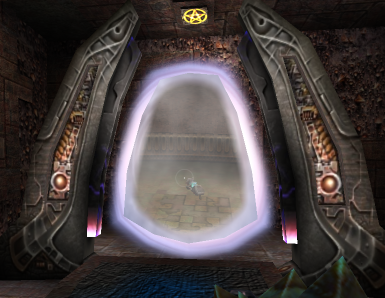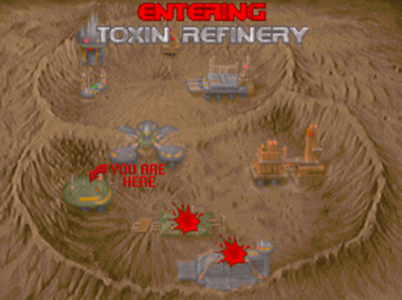In summary, while minimally and partially interactive surfaces offer only a subset of the main game UI, a Fully Interactive Surface uses a UI with the approximatly same bandwidth and fidelity as the game it is embedded in, offering most if not all of the same degrees of freedom in about the same way. If the surface UI is (almost) identical to the main game interface, the interactive surface becomes as transparent as a portal.
Playing Terminal DOOM, you can experience this. There is a moment, right after you walked up to the terminal and brought up the classic DOOM menu, after starting a shareware episode game - right after mouse control is transfered from DOOM3 to classic DOOM - where you cross the threshold from one location to the other. Unlike the PDA, the Terminal DOOM view is not presented in fullscreen mode [6], as you can still see some of the DOOM3 surroundings at the periphery of the screen. Events in DOOM are reflected in DOOM3: DOOM screen flashes illuminate the DOOM3 level in which your avatar stands in front of a flatscreen playing DOOM - but you find yourself racingh through E1M1, playing a different game. You stepped through the Looking Glass. It is this easy, seamless transition that gives interactive surfaces their power. Ultimately, they might offer an immersive experience in which the player is here and there, existing in two locations neither of which is located in the real world.
Is Terminal DOOM making DOOM3 more interactive, more immersive? No, because our actions within the DOOM context have little if no impact on the DOOM3 context. Playing classic DOOM in DOOM3 does not affect the state of the DOOM3 world in any meaningful way. In this respect, Terminal DOOM is missing the point the same way Super Turbo Turkey Puncher does. Terminal DOOM offers all the width and pacing a Fully Interactive Surface needs to fully engage and immerse the player, but it does not close and tighten the feedback loop that connects the player with the virtual world. If we are looking for game design applications of FIS, we have to look elsewhere.
[6] In my view, the decision to show the DOOM3 PDA in a fixed fullscreen presentation reduced the immersiveness of the game. It is the peripheral vision, the play of light and shadow around the flatscreen the player is looking at, the sounds from DOOM3 intruding, even the ability to move while looking at the screen, that keep us there. In contrast, the DOOM3 PDA throws us back into Windows Desktop mode, out of the game's context.

